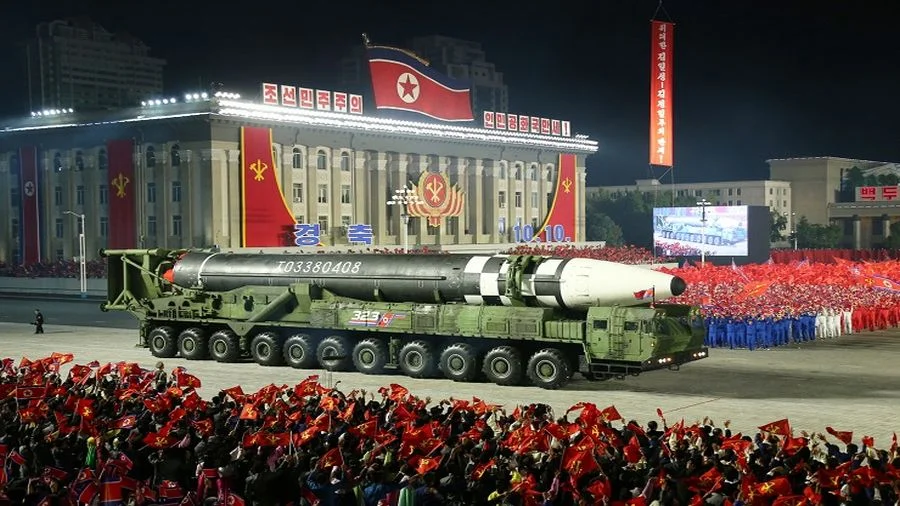Another Half Step to the Dangerous Line
Just when the author thought that, once the North Korean “nuclear counterattack exercise” was over, he could have a rest, this, unfortunately, would not come to pass! The tension continues unabated and the dangerous line is one step closer.
There have been many developments, so it is easier to present the situation on a day-to-day basis.
October 12
Kim Jong-un led test launches of two strategic long-range cruise missiles by the Tactical Nuclear Operation Unit. He expressed satisfaction at the high capability of the nuclear forces to respond to a potential threat and said the tests were another “clear warning to enemies” and a demonstration of the deterrent capability of his country’s armed forces.
The South Korean military detected the missile launches but did not report them to the media “because cruise missile launches, unlike ballistic missiles, are not a violation of UN Security Council resolutions.” However, Russian military expert Vladimir Khrustalev notes that: A) these missiles with possible nuclear warheads have at least been accepted for prototype operation by the military; B) in nearly 3 hours, the missile flew about 2,000 km in circles and eights, which is enough to hit targets throughout South Korea and Japan from unexpected angles.
October 13
US forces in the ROK conducted a 10-hour artillery exercise using multiple launch rocket systems (MLRS).
During a parliamentary inspection, the Korean Agency for Defense Development said it intends to double the size of the defense industry by 2027 and accelerate the development of a three-component missile defense system. To this end, the South Korean military is promoting the signing of an arms trade treaty with the US, and working on systematic mechanisms to facilitate access to markets in developed countries.
Between 22:30 on October 13 and 00:20 on October 14, about 10 DPRK warplanes flew about 25 kilometers north of the DMZ, prompting the South to get its F-35A fighter jets and other assets into the air.
October 14
In the morning, the DPRK fired a short-range ballistic missile into the Sea of Japan from Sunan Airfield near Pyongyang. In addition, the North Korean military fired some 170 artillery rounds into the maritime buffer zones established under the 2018 inter-Korean agreement on reducing military tensions. The buffer zones in the eastern and western waters north of the Northern Limit Line (NLL) are the de facto inter-Korean border. 130 artillery rounds were fired towards the Yellow Sea from Hwanghae Province, and about 40 rounds were fired into the Sea of Japan from Gangwon Province.
Immediately after North Korea launched a short-range ballistic missile, the National Security Council under the ROK President met in Seoul. It noted that the North’s ballistic missile launches were in clear violation of UN Security Council resolutions, and that firing within the maritime buffer zone and military aviation flights in the border zone violated the inter-Korean military agreement of September 19, 2018.
The JCSC of the ROK also criticized the firing and said the DPRK had violated the September 19 military agreement and heightened military tensions on the Korean Peninsula through continued provocations.
Even President Yoon Suk-yeol said that by firing artillery rounds into the buffer zones, North Korea violated the inter-Korean agreement, which calls for an end to all hostile military activities between the Koreas.
However, either any large-scale exercises by both sides are counted as “hostile action,” or we all are to believe any claim that these are not provocations but self-defense. Also, while it is unnerving, firing into the buffer zones is allowed, as no troops can be stationed there.
A more sober opinion was expressed by the commander of the US Seventh Fleet, Vice Admiral Karl Thomas: “What you saw was after many years of not operating in the Sea of Japan and visiting South Korea for a couple of reasons… Us being in that area, I think, probably precipitated a little bit of his (Kim Jong-un’s – ed. note) tantrum.”
Hong Min, a senior fellow at the Korea Institute for National Unification, said in this context that if the North really wanted to ignore the agreement, it would simply introduce soldiers into the DMZ.
A spokesperson for the KPA General Staff issued a statement critical of the South’s firing the previous day and explained that “taking a serious note of this provocative action by the South Korean military in the front-line area, we took strong military countermeasures. The KPA sends a stern warning to the South Korean military inciting military tension in the front-line area with reckless action.”
South Korea has blacklisted 15 North Korean individuals and 16 institutions under its first unilateral sanctions in five years. People on the new list include officials of shipping firms and organizations linked to the North’s missile program, as well as those involved in the procurement of materials for weapons of mass destruction.
In the evening, the DPRK fired again, sending another 390 shells into the buffer zones. Not a single shell landed in South Korean waters.
October 15
DPRK media published an urgent statement by a spokesperson for the KPA General Staff explaining the evening’s firing. This was in response to similar firing from the South, after which the General Staff “once again issued a clear warning to the enemy against repeated deliberate provocation on the front line.” South Korean troops must immediately cease their reckless provocative actions, because the North will respond with consistent and overwhelming military countermeasures.
October 17
South Korea’s armed forces have launched the Hoguk field training exercise, which will last until October 28. There is a high probability that North Korea will commit further unfriendly acts, so the South Korean military is closely monitoring the activity of North Korean troops. The Hoguk exercise is held annually in the second half of the year. They are defensive in nature, aimed at maintaining the combat readiness of the armed forces and enhancing the coherence of the different branches of the armed forces in joint operations. This time land, naval and air forces will practice a scenario in response to a nuclear missile threat from North Korea. Some maneuvers will involve US military forces, which will enhance the ability of the two countries’ militaries to work together.
In practical terms, a live-fire exercise using multiple launch rocket systems has begun in Chorwon, 71 kilometers northeast of Seoul.
October 18
North Korea fired artillery rounds into buffer zones in the waters of the Sea of Japan and the Yellow Sea: 100 shells from the west coast and 150 shells from the east coast.
The US military in Korea said it conducted a “combined quick reaction force training” with South Korean special forces last week.
October 19
North Korean artillery fired about a hundred shells towards the Yellow Sea. According to the Joint Chiefs of Staff of the ROK Armed Forces, the shelling came from Yonan-gun county, Hwanghae-namdo province. All the shells fell in the western buffer zone; territorial waters were not affected.
On the morning of October 19, the spokesperson of the KPA General Staff announced that “not only on October 13 and 14, but also on October 18 on the demarcation line the enemy again staged a military provocation, annoying us” by firing “dozens of rockets,” in response to which the KPA was ordered to “fire warning shots towards the eastern and western seas on the evening of October 18 as powerful military countermeasures”: “the enemy must immediately cease reckless and irritating provocative actions causing military tension in the front-line area.”
But the first warning was followed almost immediately by the second one: on that day “the enemy again staged a military provocation, firing more than 10 rockets in the zone of the front line” (apparently referring to some element of the Hoguk exercise), in response to which “the KPA General Staff ordered the eastern and western frontal units of the army to once again fire warning shots.”
South Korea and the United States conducted a joint military exercise to cross the Namhan River, 105 kilometers south of Seoul, mobilizing some 50 vehicles, including K2 tanks, Apache attack helicopters and KF-16 fighter jets. Aircraft performed fire support and other tasks, while ground troops worked together to assemble a makeshift bridge for emergency operations to get tanks, armored vehicles and infantry across the river.
And that’s clearly not all. Apart from the Hoguk exercise, the North will still have a reason to resent and fire back.
An air show featuring the South Korean Air Force’s Black Eagles aerobatic team with 30 F-35A fighter jets will be held from October 20-23 in Sacheon, Gyeongsangnam-do Province. The upcoming air show will feature the first domestic KF-21 Boramae fighter and high-altitude drones.
Another joint air force exercise in South Korean airspace (formerly called Vigilant Ace, suspended in 2018) will take place from October 31 to November 4. South Korea will send about 140 aircraft, including F-35A stealth fighters and F-15K fighters, while the US will send about 100 aircraft, including F-35B multi-role combat aircraft. The last air exercise of this scale was conducted by the two allies in December 2017.
The suspense of waiting for the North to finally “bang” continues as well. On October 14, Vice Defense Minister Shin Beom-chul said North Korea may conduct two or three consecutive nuclear tests as part of efforts to develop tactical nuclear weapons. Former IAEA Deputy Director Olli Heinonen thinks so too: “North Korea could conduct not one but two nuclear tests in Tunnel 3 (the infrastructure allegedly allows it) at the Punggye-ri nuclear test site.” According to the expert, Pyongyang will test tactical nuclear charges intended for a short-range ballistic missile and a cruise missile.
It is also worth noting how the South Korean and American sides try to explain the North’s behavior by ignoring the real reason – the vortex of tensions triggered by the exercises back in August, where each side considers its actions not as provocation but as a response.
According to Secretary Blinken, North Korea is launching ballistic missiles and committing other unfriendly acts to attract the world’s attention. Go Myong-hyun, a senior fellow at the Institute for Policy Studies, said that “the recent moves are assumed to be aimed at gaining international attention for its seventh nuclear test with missile launches and other provocations, and showing its force to the world”. It was not without the usual “they are begging for rice” or “the regime on the edge of collapse distracts attention with rattling weapons.”
With such analysts, the vicious circle will not stop, although the author hopes for the best. Despite the high-profile claims, the real red lines have not YET been crossed, although the author will soon have to be reminded of the risk of a “Pig War”, heightened by stress and mutual hyping up.







